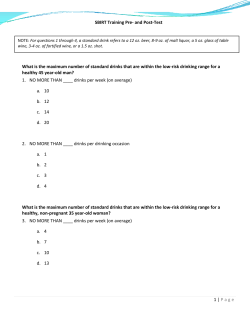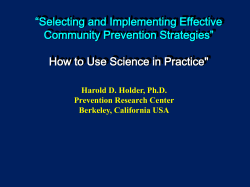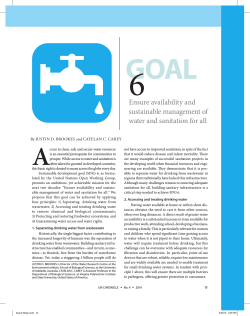
? What is & a Water Quality Issue
Water Quality & Water Quantity: The Issues What is Quality Issue ? a Water Anything that causes a problem with, or has the potential to cause a problem with, the quality of municipal drinking water is considered a water quality issue. Issues may occur at the source of the drinking water, such as at a surface water intake or municipal wellhead, or it may occur in a location used to monitor the local source of water. In general, water quality issues are chronic, which means they have existed over a long period of time or reoccur seasonally, and are likely to continue if nothing is done to correct them. Water quality issues exist when contamination approaches or passes acceptable provincial levels. Issues impacting water quality may include contaminants such as roads salt, non-point sources of contaminants such as runoff and multiple sources of discharges such as sewage treatment plant effluent. Under the Clean Water Act, 2006, drinking water quality issues, documented through the planning process, will be linked to specific land uses so that actions can be taken to manage them. In understanding the sources of these problems, source protection committees can focus immediate actions based on their order of greatest concern. What is Quantity Issue ? a Water The word stress is used to talk about problems with water quantity, or the ability of a drinking water system to supply enough water. It is important to understand when, where and how water is leaving a drinking water source and compare it to how quickly that source can be naturally replenished. It is also important to look at water takings and water supply trends. What results from looking at all of these factors is a water budget, which is useful in predicting water supply shortages and planning for those shortages. Water quantity stresses can lead to water quality issues as too little water in a source can mean contaminants are more concentrated and therefore, may be above acceptable levels. Water quantity stressors include water that is taken by municipalities for drinking water; water that is taken by industry for manufacturing processing; water that is taken by business for activities such as food and beverage processing; water that is taken by agricultural for irrigation; and even private well use. Under the Clean Water Act, 2006, drinking water takings will be compared to the amount of water available, in order to better plan for and find solutions to both current and future water quantity needs. Water Quality & Water Quantity: What are Potential Water Quality Issues ? ? The Issues Pollutants from a variety of activities on the land can seep into the ground and move toward a wellhead or surface water source of drinking water and become a water quality issue. Examples of human activities that could negatively affect local water quality if not managed properly include: Chemical storage Spreading sewage treatment sludge Storing and spreading road salt Animal feedlots Use of fertilizers and pesticides Accidental spills of hazardous materials Septic systems Underground storage tanks Underground pipelines or sewers Landfills Wastewater discharge Sewage bypasses Storm water runoff What are Potential Water Quantity Issues ? Taking too much water from a source of water, such as a surface water body or aquifer, can mean that the water source is stressed. This may develop into to a water quantity issue should more water be taken from a source than can be naturally replenished. Some of the common reasons for taking water include: Municipal water takings for domestic, industrial, commercial and institutional use Agricultural water takings Private wells taking water for domestic use Industrial takings such as for aggregate extraction, mining, forestry, food processing, bottled water and greenhouse operations Recreational takings such as for golf courses and bait harvesters in some areas of Ontario What are the Benefits of Preventing Water Quality and Quantity Issues ? Taking steps to protect the quantity and quality of our drinking water sources is important. The primary reason to do this is to protect public health. Also, it costs a lot less to prevent problems in the first place. Other benefits of protecting water quality and quantity include: Not having to find new drinking water sources when old ones become contaminated Avoiding the need to clean up contaminated water Reducing the cost of water treatment Ensuring a long-term supply of clean water Ensuring a positive climate for economic growth Water Quality & Water Quantity: The Issues What can you do to Protect the Quality and Quantity of Your Water Sources ? It is important to take steps to protect both the quality and quantity of local drinking water sources. Everything is connected through the water cycle and it is important to remember everyone lives downstream. What you do today can affect local water quality and quantity. These are some of the things you can do to protect your water: 1 Conserve water. Not only is conserving water helpful to maintaining a constant supply of drinking water, too little water in a source can mean contaminants are more concentrated and, therefore, may be above acceptable levels. 2 Be an avid recycler. Recycling paper products, glass, metals and plastics cuts down on pollution and also reduces the amount of water we use. Manufacturing recycled paper uses 58% less water than making paper from virgin wood pulp. Making glass from recycled materials cuts related air pollution 20% and water pollution 50%. 3 Dispose of hazardous waste properly. Take unused paints, cleaners, pesticides, and medical prescriptions to your local hazardous waste facility. Take used engine oil to recycling facilities. Use drop cloths or tarps when working with hazardous materials such as paints, driveway sealers or wood stain to prevent spills from leaking into the ground. If a spill occurs, clean it up with an absorbent material such as kitty litter or sawdust and scoop the contaminant into a container. 4 5 6 Use non-toxic products for cleaning and environmentally-friendly soaps, shampoos and personal care products. Remember that what you use in your house goes back down your drain. 7 Take care when refueling gas tanks for cars, lawn mowers, chainsaws, weed trimmers, tractors or other machinery to avoid spilling fuel on the ground. Also take care when changing engine oil. One litre of gas or oil can contaminate a million litres of groundwater. 8 Take your car to commercial car washes designed to prevent pollutant runoff from entering storm sewers. Use commercial car washes that use water efficient sprays, reducing their water consumption. 9 Clean up pet waste which contains nutrients and pathogens that can run into storm sewers during a rain storm. Prevent pollutants from entering into runoff by reducing or eliminating the use of pesticides, fertilizers, sidewalk salts and by not over-watering your lawn. If you run an agricultural operation and haven’t already, consider developing and implementing a Nutrient Management Plan. Stay informed and get involved in your local source protection process. To find a Drinking Water Source Protection Planning Region or Area near you go to www.conservation-ontario.on.ca Water Quality & Water Quantity: Some additional ways to protect water for those who live on rural properties include: 1 The Issues Keep your septic system in proper working order and empty the tank regularly. 2 Protect and maintain your private well. Wells provide pathways for contaminants to enter the groundwater. If you have a well, be sure it is sealed properly and if you own a well you no longer use, have it properly decommissioned by a licensed well technician. Test your well water regularly to ensure the water is safe to drink. 3 Manage animal waste on farms to prevent water contamination. If you operate a farm, contact your local Ontario Soil and Crop Improvement Association (OSCIA) at www.ontariosoilcrop.org or your local conservation authority at www.conservation-ontario.on.ca for information about workshops you can take to assist you in developing an Environmental Farm Plan (EFP) for your farm business. 4 Manage livestock grazing. Overgrazing exposes soil and increases erosion. 5 Protect the vegetation along the banks of ponds, streams and lakes to help control erosion, provide food for aquatic life, and maintain cooler water temperatures necessary for some species of fish. For More Information on Highly Vulnerable Areas Please contact your local Source Protection Region or Area: 120 Bayview Parkway, Box 11, Newmarket,ON L3Y 4W3 Tel.: 905.895.0716 Fax: 905.895.0751 info@conservation-ontario.on.ca www.conservation-ontario.on.ca For more information on the Source Protection Program, please visit the Ministry of the Environment’s website: www.ene.gov.on.ca/en/water/cleanwater/sourceprotection.php This project has received funding support from the Ontario Ministry of the Environment. Such support does not indicate endorsement by the Ministry of the contents of the material. November 2007
© Copyright 2025





















